Ancient Indian History – Indus Valley Civilization, Mohenjo Daro, Harappan Culture
The past of India goes back several thousand years. We learn about it from the evidences which our ancestors have left behind. Even when the paper was not made.
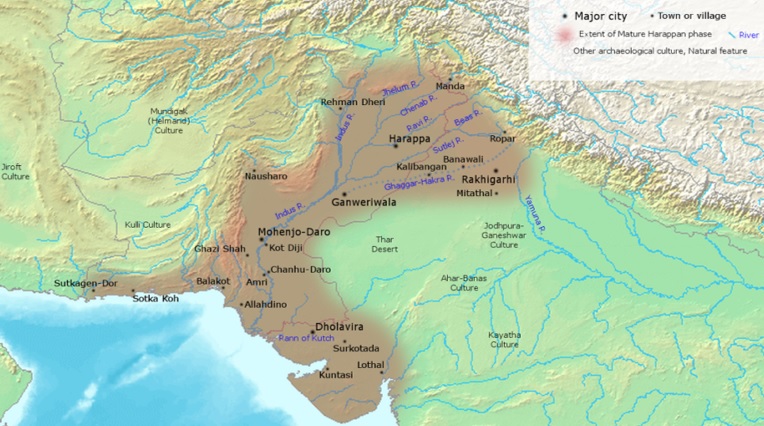
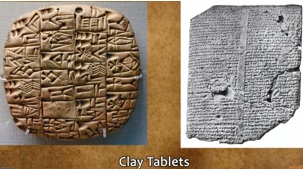
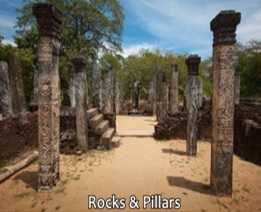
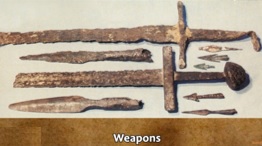
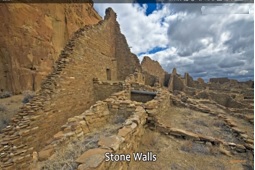
Indus Valley Civilisation is a bronze age that was located in the north western region of Indian subcontinent. Since many of the Harppan settlement are found on the vast plane of river Saraswati which is dry today. It is also called as Indus-Saraswati Civilization. The Harrappan culture was spread over the many part of India like Sindh, Baluchistan, Punjab & Haryana, Western Uttar Pradesh, Jammu, Rajasthan, Gujarat and Northern Maharashtra. The important Harappan sites are Kotoji located on left bank of river Indus opposite Mohenjodaro, Harappa, KaliBanga, Mehrgarh, Mundigak, Damb Dadaat, Amri, Gumla, Rehman Dehri, Dolavira, Lothal.
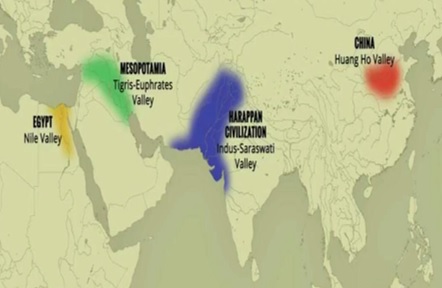
The Harappan culture lasted for more than a thousand years. The world’s earliest urban civilization came to an end around 1300 BC. Natural calamities like floods, teriible epidemic diseases, and attack by wild animals are the suspected reasons for their decline. Although some aspects of the Harappan culture continued after their decline, those who succeeded Harappans knew nothing of city life. Thus decline of the Harappan culture was a negative event in the history of India.
Unique Feature of the Indus Valley Civilization
- The structure of the houses has toilet connected to a centralized system.
- Sanitation system is planned and organized by a centralized government.
- Unique size of bricks everywhere
- Town Planning
Indus Valley Civilization History
- Mature period began around 2700 BCE.
- Harappa was established around 3300 BCE.
- Farming and agriculture became the main economic activity due to scarce metal resources.
- Trading with Sumerian civilization have been progressed along the shore Arabian Sea and the Persian Gulf.
- Most artifacts unearthed were toys indicating that they liked entertainment and loved to play.
- For a while, archaelogists thought that the cities of the Indus Valley Civilzation were populated by children.
- Their dissolution of IVC remains a mystry.
The lives of the people in Indus Valley Civilization
- AGRICULTURE was their main economic activity.
- They had irrigation systems.
- Pottery and Jewellery making

- Houses were made of clay bricks
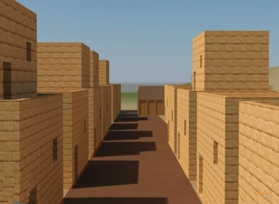
- Their religion was animism and polytheism. They worshipped many gods some animal like revered BULL.
- Their social classes were lived inside the citadels; the farmer and trader lived outside of citadel.
Indus Valley Civilization Notes
- Indus Civilisation is one of the four earliest civilisations of the world along with the civilisations of Mesopotamia (Tigris and Euprates), Egypt (Nile) and China (Hwang Ho).
- The civilization forms part of the proto-history of India and belong to Bronze age.
- The most accepted period is 2500-1700 BC (by Carbon-14 dating).
- Dayaram Sahni first discovered Harappa in 1921.
- RD Banerjee discovered Mohenhodaro or Mound of the Dead in 1922.
Nomenclature of Indus Valley Civilisation
- Indus Valley Civilisation as it flourished along the Indus river.
- Harappan Civilisation named by John Marshall after the first discovered site, Harappa. Harappa comes in the Pakistan now.
- Saraswati-Sindhu Civilisation as most of the sites have been found at the Hakra-Ghaggar river.
Geographical Spread
- The civilisation covered parts of Sind, Baluchistan, Afghanistan, West Punjab, Gujarat, Uttar Pradesh, Haryana, Rajasthan, Jammu and Kashmir, Punjab and Maharashtra.
- Mundigak and Shortughai are two sites located in Afghanistan.
- West-Sutkagendor on Makran coast (Pak-Iran Border) East-Alamgirpur in Uttar Pradesh (River Hindon).
- North-Manda in Jammu (River Chinab). South-Daimabad in Maharashtra (River Pravara) are major sites.
Some New Discoveries
- Ganverivala in Pakistan by Rafeeq Mugal.
- Rakhigarhi in Sind (Haryana) by Rafeeq Mugal
- Dholavira on bank of river Luni in Gujarat excavated by RS Bist and JP Joshi is largest excavated site in India.
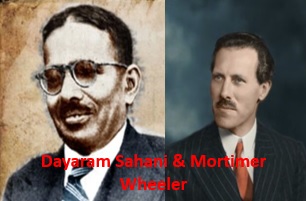
Who Built the Indus Valley Civilization
Indus Cities
| City | Province | River bank | Year of Dis. |
Archaelogists |
| Harappa | Pakistani Punjab | Ravi | 1921 | Daya Ram Sahni |
| Mohenjodaro | Sindh | Indus | 1922 | RD Banerjee |
| Ropar | Indian Punjab | Sutlej | 1953 | YD Sharma |
| Lothal | Gujarat | Bhogava | 1957 | SR Rao |
| Kalibangan | Rajasthan | Ghaggar | 1959 | BB Lal |
| Chanhudaro | Sind | Indus | 1931 | MG Majumdar |
| Alamgirpur | Uttar Pradesh | Hindon | 1974 | YD Sharma |
| Sutkagendor | Baluchistan | Dasht | 1931 | Aurel Stein |
| Banawali | Haryana | Ghaggar | 1974 | RS Bist |
| Rangpur | Gujarat | Bhadur | 1931 | MS Vats |
Town Planning
- Town planning was not uniform. A common feature was grid system i.e. streets cutting across one another at right angles, dividing the town into large rectangular blocks.
- The towns were divided into two parts : upper part or citadel and lower part.
- The fortified citadel on the Western side housed public buildings and members of ruling class. IN this, religious activities, public gatherings or important administrative activities.
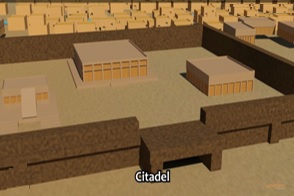
- Below the citadel on the Eastern side lay the lower town inhabited by the common people. The streets are done in grid pattern.
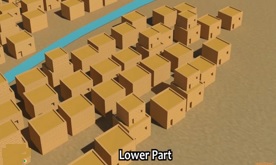
- Underground Drainage System connected all houses to the street drains made of mortar, lime and gypsum. They were covered with either bricks or stone slabs and equipped with its ‘Manhole’. This shows developed sense of health and sanitization.
- The Great Bath or Swimming Pool (Mohenjodaro) It was used for religious bathing. Steps at either end lead to the surface. With inlet to the tank and outlet to the drain water. There were changing rooms alongside. No usage of stones.
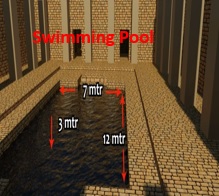
- The Granaries (Harappa) 6 granaries in a row were found in the Citadel at Harappa.
- Houses were made up of burnt bricks. They were often two or more storeyed, varied in size, with a square courtyard around which number of rooms. Windows did not face the main streets. They had tiled bathroom.
- Lamposts were erected at regular intervals. It indicates the existence of street lightening.
Agriculture
- Agriculture was the backbone of the civilisation. The soil was fertile due to innundation in the river Indus and flooding.
- The Indus people sowed seeds in the flood plains in November, when the flood water receded and reaped their harvests of wheat and barley in April, before the advent of next flood.
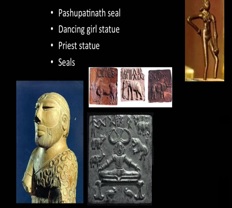
- They used wooden plough share (ploughed field from Kalibangan) and stone sickles for harvesting.
- Gabarbanda or nalas enclosed by dam for storing water were a feature in parts of Baluchistan. Grains were stored in granaries.
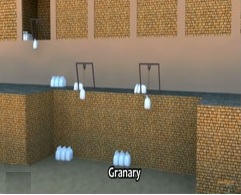
- Crops Produced wheat, barley, dates, peas, sesamum, mustard, milet, ragi, bajra and jowar. At Lothal and Rangpur rice husks were found.
- They were first to produce cotton in the world, which Greek called as Sindon derived from Sind. A fragment of woven cotton cloth was found at Mohenjodaro.
- Well Irrigation is evident from Alladinho, dams and irrigation canals from Dholvira. Sugarcane was not known to Indus people.
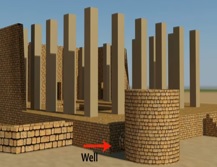
Domestication of Animals
- Animal rearing was practiced mainly humped bull. They domesticated buffaloes, oxens, sheep, asses, goats, pigs, elephants, dogs, cats etc.
- Camel bones are reported at Kalibangan and remains of horse from Surkotada.
Trade
- Agriculture, industry and forest produce provided the basis for internal and external trade.
- Trade was based on barter system. Coins are not evident, bullock carts, pack animals and boats were used for transportation.
- Weights and measures were made of limestone, steatite etc. Generally in cubical shape. They were in multiple of 16.
- Several sticks inscribed with measure marks have been discovered. It points that linear system of measurement was in use.
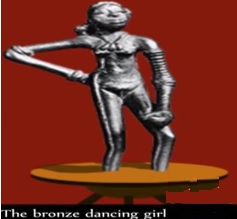
- Foreign trade flourished with Mesopoyamia or Sumeria (Iraq), Central Asia, Persia, Afghanistan and Bahrain.
- Sumerian text refers to trade with Meliha (Indus) while Dilmun (Bahrain) and Makan (Makran coast) were two intermediate stations.
Towns Associated with Different Industries
- Daimabad Bronze industry
- Lothal Factory for stone tools and metallic finished goods.
- Balakot Pearl finished goods, bangle and shell industry
- Chanhudaro Beads and bangles factory
- Lothal (artificial dockyard) – Surkotada, Sutkagendor, Prabspattan, Bhatrao, Kalibangan, Dholavira, Daimabad were coastal towns of the civilisation.
- Major Exports Agricultural products, cotton goods, terracotta figurines, pottery, stetite beads (from Chanhudro), conch-shell (from Lothal), ovory products, copper etc.
Major Imports
| Imports | From |
| Gold | Kolar (Karnataka),Afghanistan, Persia (Iran) |
| Silver | Afghanistan, Persia (Iran), South India |
| Copper | Khetri (Rajasthan), Baluchistan, Arabia |
| Tin | Afghanistan, Bihar |
| Lapis Lazuli and Sapphire | Badakhshan (Afghanistan) |
| Jade | Central Asia |
| Steatite | Shaher-i-Sokhta, Kirthar Hills |
| Turquoise | Iran |
| Amethyst | Maharashtra |
Art and Craft
- Harappans used stone tools and implements and were well acquainted with bronze. Bronze was made by mixing copper (from Khetri) with tin.
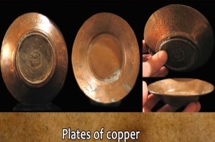
- Boat making, jewellery of gold, silver precious stone and bead making was practiced. Cotton fabrics were used in summer and woollen in winter.
- Both men and women were very fond of ornaments and dressing up.
- Pottery both plain (red) or painted (red and black) pottery was made. Pots were decorated with human figures, plants, animals and geometrical patterns and ochre was painted over it.
- Seals were made of steatite pictures of one horned bull (the most), buffalo, tiger, rhinocerous, goat and elephant are found on the seals. They marked ownership of property.
- Mesopotamian seals were found from Mohenjodaro and Kalibangan; Persian seal from Lothal. Most important one is Pasupati seal.
- Metal images Bronze image of nude woman dancer (identified as devdasi) and stone steatite image of a beared man (both obtained from Mohenjodaro).
- Terracotta figurines Fire baked clay was used to make toys, objects of worship, animals (monkey, dogs, sheep, cattle, humped and humpless bulls), cattle toys with movable head, toy-carts, whistles shaped like birds and both male and female figurines.
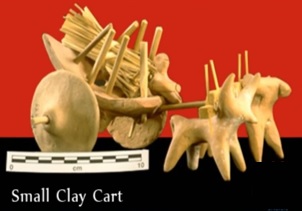
- They played dice games. Gambling was favourite time pass. No clear evidence of music.
Religious Practices
- Chief Female Diety A terracotta figure where a plant ishwon growing out of the embryo of a woman, represents Mother Goddess (Goddess of Earth).
- Chief Male Diety Pashupati Mahadeva (Proto-Shiva), represented in seals as sitting in a yogic posture on a low throne and having three faces and two horns. He is surrounded by an elephant, a tiger, a rhino and a buffalo and two dear appear at his feet.
- Lingam and yoni worship was prevalent. Trees (pipal), animals (bulls, birds, dove, pigeon) unicorn, and stones were worshipped. No temple has been found though idoltary was practised.
- Indus people believed in ghosts and evil forces and used amulets as protection against them. Fire altars are found at Lothal and Kalibangan.
- Evidence of snake worship is also found.
Burial Practices
- General practice was extended inhumation in North-South direction.
- Mohenjodaro Three forms of burial complete, fractional and post cremation.
- Kalibangan Two forms of burial-circular and rectangualr grave.
- Surkotada Pot-burial, Dholavira-Megalithic burial.
- Lothal Double burial
- Harappa East-West axis; R-37 and H cementary.
Script
- It was pictographic in anture. Fish symbol is most represented.
- Overlapping of the letters show that it was written from right to left in the first line and then left to right in the second line. the style is called Boustrophedon.
Decline of the Cuvilisation
The Harappan culture flourished about 1800 BC , then it began to decline. There is no unanimity among historians regarding reason fro the decline of this urban civilisation. there are many different theories that shows the decline of the Indus culture.
| Theory | Reasons for Decline |
| Gorden Childe HT, Lambrick Kur, Kendey Orell and AN Ghosh | External aggression, Unstable river systems, Natural calamity and Climate change |
| R Mortimer Wheeler, Robert Raiker, Sood & Aggarwal | Aryan invasion, Earthquake, Dryness of river and Ecological imbalance |
Important Harappan Sites
| City | Archaelogical Finds |
| Harappa (Gateway city) | 2 row of granaries with brick platform, work men’s quarter, stone symbol of lingam and yoni, virgin-Goddess, clay figures of mother Goddess, wheat and barley in wooden mortar, copper scale and mirror, vanity box, dice. Sculpture Dogs chasing a deer (bronze), nude male and nude dancing female (stone), red sand stone male torso. |
| Mohenjodaro (Mound of the Dead) | The great bath, The great granary (largest building), multi-pillared assembly hall, college, proto-Shiva seal, clay figures of mother Goddess, Dice. Sculpture Bronze dancing girl, steatite image of bearded man. |
| Kalibangan (Black Bangle) | Decorated bricks, bangle factory, wheels of a toy cart, wells is every house. Remains of a massaive brick wall around both the citadel and lower town (lower town of Lothal is also fortified), bones of camel, tiled floor, Mother Goddess figurines are absent here. |
| Chanhudaro (lancashire of India) | Inkpot, lipstick, carts with seated driver, ikkas of bronze, imprint of dog’s paw on a brick. Only city without Citadel. |
| Daimabad | Bronze images of Charioteer with chariot, ox, elephants and rhinoceros. |
| Amri | Actual remains of Rhinoceros. |
| Alamgirpur | Impression of cloth on a trough |
| Lothal (Manchester of Indus Valley Civilisation) | Rice husk, fire altars, grinding machine, tusks of elephant, granomy, terracotta ship, houses with entrance on main streets, impressions of cloth on some seals, modern day chess, instrument for measuring 180 and 90 and 45 degree angles. |
| Ropar | Buildings made of stone and soil. Dog buried with human. One inscribed steatite seal with typical Indus pictographs, oval pit burials. |
| Banawali | Oval shaped settlement, only city with radial streets, lack of systematic drainage pattern. Toy plough, largest number of barley grains. |
| Surkotada | Both Citadel and lower town fortified with stone wall. First actual remains of horse bones. Cemetry with for pot burials. |
| Dholavira | Only site to be divided into 3 parts. Giant water reservoir, unique water harnessing system, dams and embankments, a stadium, rock-cut architecture. |
| Sutkagendor | Two fold division of township-Citadel and lower town. |
Possible Causes of Disappearance
- Famine, hunger, drought
- Ecological factors/ Natural disasters (flood, typhoon, earthquake, volcanic eruption etc.)
- Periodic flooding of indus leading to desertion of cities.
- Invasions by another civilization Aryans.
Indus Valley Civilization PDF Download
You can also download Indus Valley Civilization PDF on clicking below link.
Download Indus Valley Civilization as PDF
Indus Valley Civilization Multi Choice Questions (MCQ)
Please practice below questions also by clicking on below link.
Most Important 50 MCQ of Indus Valley Civilization
All the best for your upcoming exam!
You can join or visit at Facebook Page or Twitter for always keep in touch with further updates.
Read more articles….

unable to download whole pdf..can download only initial 3 pages..pls help how to download complete pdf..
thank you
Hi Nitish, You can download full PDF by clicking on link Thank You
thank you..these notes are really good…can you provide link for other history notes also..it will be very helpful
Mohenjo-daro is located west of the Indus River in Larkana District, Sindh, Pakistan, in a central position between the Indus River and the Ghaggar-Hakra River.